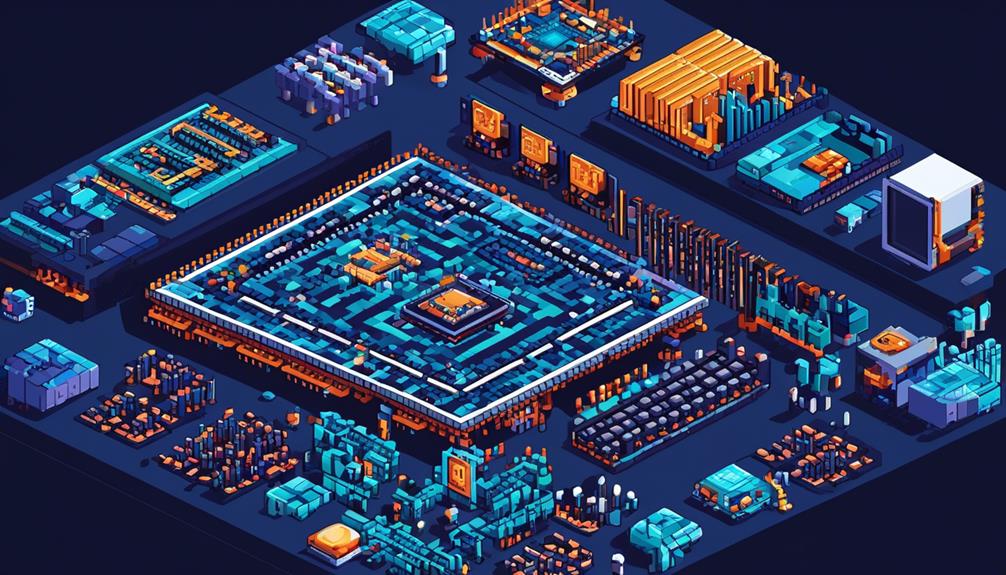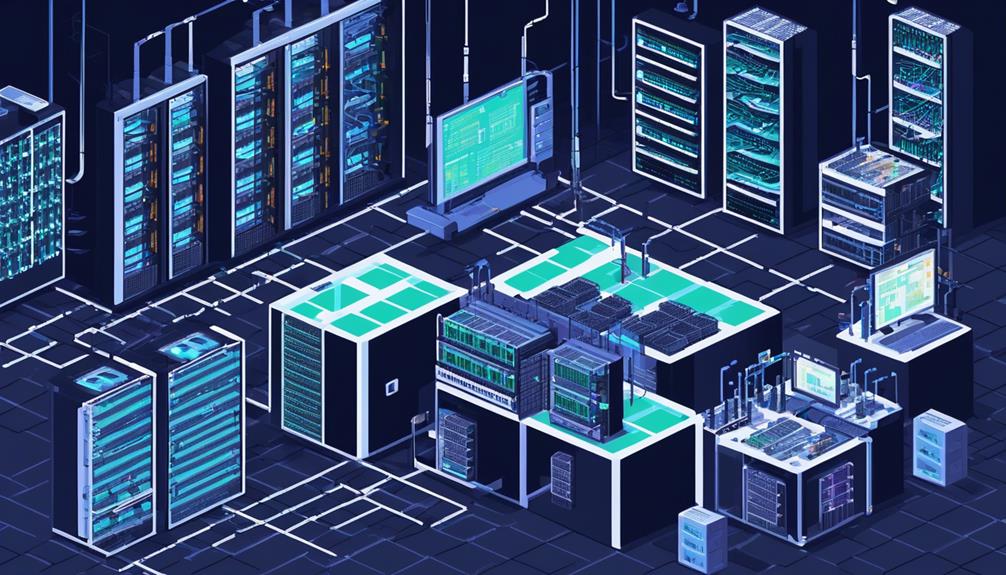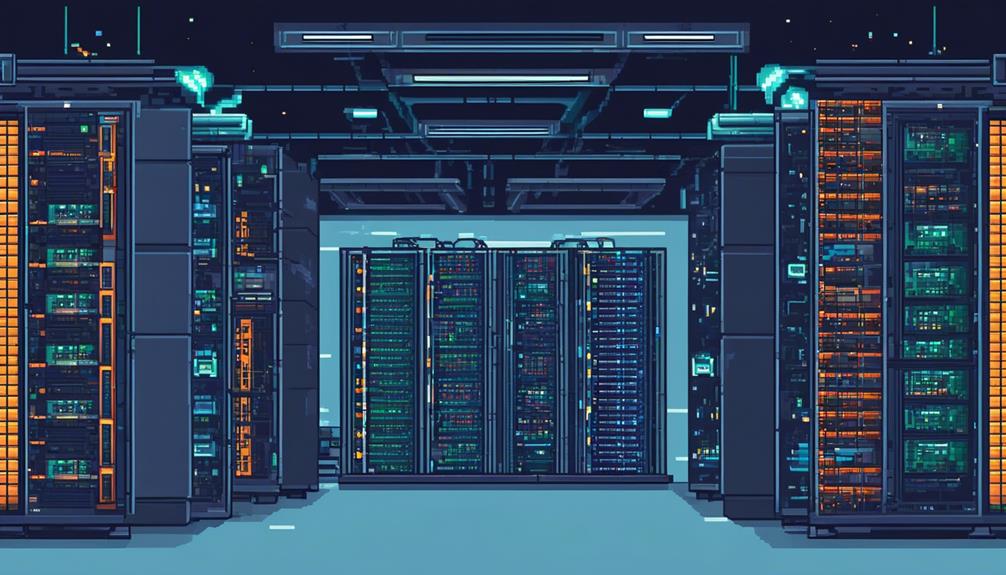Cloud infrastructure hardware is the backbone of modern-day computing, providing the necessary resources to support the ever-growing demand for cloud services. From servers to networking equipment, each component plays a vital role in delivering seamless and efficient cloud experiences to users.
But what are the essential elements that make up this infrastructure? How do they work together to ensure the smooth operation of cloud environments?
In this discussion, we will delve into the core hardware components, explore the intricacies of server, network, and storage infrastructure, and uncover the advancements in virtualization technology that enable the dynamic allocation of resources.
By understanding these essentials, we can gain a deeper appreciation for the underlying infrastructure that powers the cloud and the possibilities it holds for the future.
Key Takeaways
- Servers, power supplies, CPUs, memory, and storage are core hardware components of cloud infrastructure.
- Server infrastructure serves as the foundation for cloud computing, providing computing services over the internet.
- Network infrastructure facilitates connectivity and communication between cloud components, supporting data transmission and secure communication.
- Storage infrastructure provides hardware and software components to efficiently store and manage data, with different deployment models available.
Core Hardware Components

Core hardware components are fundamental elements required for computing and storing data in cloud infrastructure. These components play a crucial role in enabling the delivery of computing services, storage, and applications by cloud providers. Cloud deployment models rely heavily on the compute and storage infrastructure, which is composed of physical resources such as servers, power supplies, memory, storage, and CPUs.
Servers are at the heart of cloud infrastructure, providing the necessary computing power, memory, and storage to support various cloud services. They form the backbone of cloud computing, allowing users to access applications and data remotely. Power supplies are essential to ensure uninterrupted operation of the hardware components, as any disruption in electricity can lead to service downtime and data loss.
CPUs, or central processing units, play a vital role in executing instructions and processing data within the cloud infrastructure. They are responsible for the rapid processing of tasks, enabling the efficient delivery of cloud services. Memory is another critical component that allows for the temporary storage of data, ensuring quick access and retrieval.
Storage is a fundamental aspect of cloud infrastructure, as it provides a means to store and manage vast amounts of data. It allows users to save and access their files, applications, and other digital assets from anywhere, at any time. The storage capacity and performance of the hardware components directly impact the overall effectiveness and efficiency of the cloud infrastructure.
Server Infrastructure
Server infrastructure serves as the foundation for cloud computing, providing the necessary physical and virtual resources to deliver computing services over the internet. It encompasses a range of hardware components, including servers, power supplies, memory, and storage, as well as virtualization technology that decouples the computing infrastructure from the physical hardware.
Cloud infrastructure providers are responsible for building and maintaining server infrastructure to ensure uninterrupted connectivity and high-bandwidth access to cloud computing resources. This infrastructure can be deployed as part of private, public, or hybrid clouds, offering different levels of control, security, and flexibility to organizations.
The role of server infrastructure is crucial in delivering on-demand access to cloud resources, meeting the needs of cloud customers through rapid provisioning and scalable computing capabilities. By leveraging virtual resources, data centers equipped with server infrastructure can efficiently handle the compute-intensive workloads of cloud customers, allowing them to run their applications and store their data in the cloud.
Server infrastructure is one of the key elements of cloud infrastructure services. It provides the backbone for delivering a wide range of computing services to customers, such as virtual machines, containers, serverless computing, and cloud storage. The reliability and performance of server infrastructure directly impact the quality of cloud services provided to customers.
Network Infrastructure

Network infrastructure serves as the essential framework for cloud computing, facilitating connectivity and communication between various components. It encompasses a range of hardware components, including routers, switches, and firewalls, as well as networking protocols and technologies.
The network infrastructure plays a crucial role in enabling data transmission, traffic management, and ensuring secure and efficient communication within the cloud environment. It is responsible for supporting on-demand self-service, broad network access, and rapid elasticity, which are fundamental characteristics of cloud computing.
In the context of cloud computing, network infrastructure is particularly important for private and public cloud environments. Private clouds are dedicated to a single organization, requiring robust and reliable networking capabilities to ensure seamless communication between different parts of the infrastructure. Public clouds, on the other hand, serve multiple clients and require scalable and flexible networking solutions to accommodate the diverse needs of various users.
Cloud vendors invest heavily in designing and implementing robust network infrastructure to deliver reliable and high-performance cloud services. They prioritize the integration of storage and networking capabilities to efficiently deploy applications and manage data storage within the cloud environment.
Storage Infrastructure
Storage Infrastructure is a critical component of cloud computing, providing the necessary hardware and software components to store and manage data efficiently. Here are four key aspects of storage infrastructure in cloud environments:
- Storage Devices: Storage infrastructure includes various types of storage devices such as hard drives, solid-state drives (SSDs), and storage area networks (SANs). These devices offer different levels of performance, capacity, and reliability to meet the diverse needs of cloud users.
- Data Protection Mechanisms: To ensure data availability and integrity, storage infrastructure incorporates data protection mechanisms like backup, replication, and disaster recovery. These mechanisms help in safeguarding data against accidental deletion, hardware failures, and natural disasters.
- Scalability and Flexibility: Cloud infrastructure hardware allows storage infrastructure to scale horizontally and vertically. Horizontal scaling involves adding more storage devices to accommodate growing data demands, while vertical scaling involves increasing the capacity and computing power of existing storage devices. This scalability and flexibility enable cloud users to adapt their storage infrastructure to changing workloads and business requirements.
- Different Deployment Models: Storage infrastructure can be deployed in different ways to meet specific needs. Private cloud deployments provide dedicated storage resources for a single organization, ensuring enhanced data security and control. Public cloud providers like Amazon Web Services offer storage infrastructure as a service, allowing organizations to access storage resources on-demand. Hybrid cloud deployments combine private and public cloud storage infrastructure, providing the benefits of both flexibility and data control.
Virtualization Technology

Virtualization technology serves as a crucial component in cloud infrastructure, enabling efficient utilization of hardware resources and seamless migration of virtual instances. It allows for the creation of multiple virtual instances on a single physical server, dividing hardware resources into isolated environments. This division not only optimizes resource utilization but also reduces hardware costs by running multiple virtual machines on a single physical server.
One of the key benefits of virtualization technology is its ability to facilitate easy migration of virtual instances between physical servers. This feature ensures that cloud users can move their virtual instances without disrupting their operations. This flexibility enhances the scalability and flexibility of IT infrastructure, as resources can be allocated on-demand.
To provide a better understanding, the following table highlights some popular virtualization technologies used in the cloud:
| Virtualization Technology | Description |
|---|---|
| VMware vSphere | A leading virtualization platform that enables users to build and maintain cloud environments. |
| Hyper-V | Microsoft's virtualization platform, used in Microsoft Azure, to run virtual machines and manage cloud infrastructure. |
| KVM | A virtualization technology deployed within the Linux kernel, offering open-source virtualization capabilities. |
These virtualization technologies enable cloud service providers to efficiently utilize their physical hardware, providing a reliable platform for users to deploy their virtual instances. This is especially important for organizations that need to securely store and manage their corporate data in the cloud. By leveraging virtualization technology, cloud infrastructure can deliver the necessary performance and scalability required by businesses of all sizes.
Frequently Asked Questions
What Are the 4 Components of Cloud Infrastructure?
The four components of cloud infrastructure are:
- Hardware: This includes servers, power supplies, memory, storage, and CPUs.
- Virtualization: Virtualization techniques decouple the computing infrastructure from the physical hardware.
- Storage: Storage solutions encompass block storage, file storage, and object storage.
- Network: The network infrastructure provides internal and external network connectivity.
These components must be carefully considered and optimized to address various aspects such as:
- Scalability challenges
- Security considerations
- Resource allocation strategies
- Performance optimization techniques
- Cost-effective hardware choices
- Disaster recovery mechanisms
- Hardware maintenance and upgrades.
What Hardware Is Needed for Cloud Computing?
Hardware requirements for efficient cloud computing include:
- Servers: Choosing the right servers is crucial for optimal performance and scalability in cloud infrastructure.
- Storage: Storage options, such as solid-state drives, enhance data access and retrieval.
- Networking equipment: Network infrastructure considerations ensure high bandwidth and uninterrupted connectivity.
- Interfaces: Interfaces are essential for connecting different components of the cloud infrastructure.
- Scalability: Scalability is essential for accommodating increasing workloads.
- Security: Security features, like encryption and access controls, protect data in cloud infrastructure.
- Performance optimization: Performance optimization techniques, such as load balancing, improve overall system efficiency.
- Virtualization technology: Virtualization technology enables efficient resource allocation.
- Cost-effective solutions: Cost-effective hardware solutions drive innovation in cloud infrastructure hardware.
- Future trends: Future trends in hardware technology influence the development of cloud infrastructure.
What Are the 5 Essentials of Cloud Computing?
The five essentials of cloud computing include:
- The benefits it offers, such as scalability, cost transparency, and control.
Common challenges faced in cloud computing are:
- Security concerns.
- Best practices for migration.
Additionally, virtualization plays a vital role in cloud computing:
- Enabling the efficient allocation of resources.
Comparisons between cloud computing and traditional IT infrastructure highlight the advantages of cloud services models like:
- IaaS (Infrastructure as a Service).
- PaaS (Platform as a Service).
- SaaS (Software as a Service).
What Are the Hardware Components in a Cloud Architecture?
Hardware components in a cloud architecture play a crucial role in supporting the key benefits of cloud infrastructure. Servers serve as the foundation of cloud architecture, providing computing power for various workloads.
Network infrastructure is of paramount importance in enabling connectivity and facilitating data transfer between different components.
Storage devices offer reliable and scalable storage solutions for data in the cloud.
Virtualization technology decouples computing infrastructure from hardware, allowing for flexibility and resource optimization.
Scalability, security, performance, and cost optimization are key considerations in cloud hardware design.
Advancements in cloud hardware technology continue to shape the future of cloud infrastructure.

